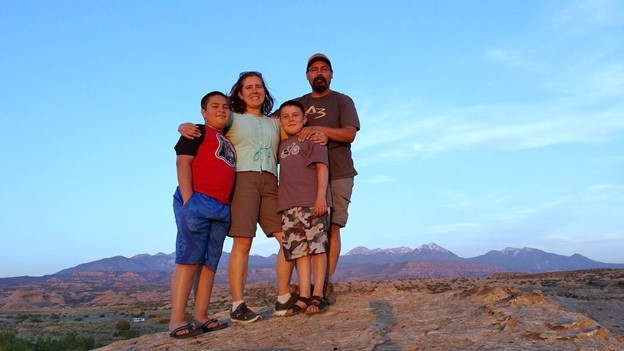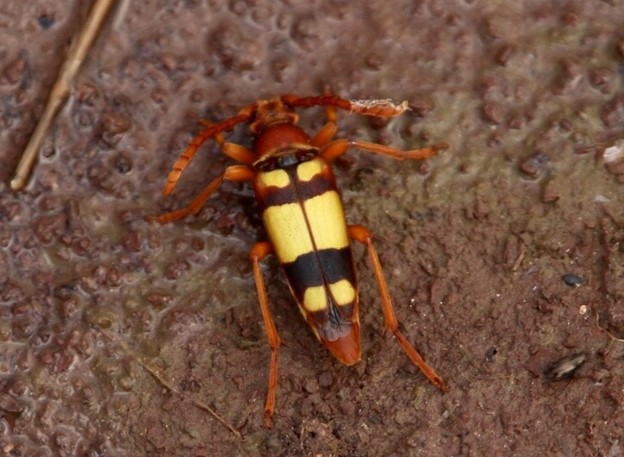|
A huge congratulations to Art for this amazing find! If you need the photos sent as separate files, just let me know. Thank you, Jackie
Kaibab National Forest employee captures first image of rare beetle
Williams, Ariz., Aug. 9, 2017—For Immediate Release. A Kaibab National Forest employee recently captured the first and only known image of a rare beetle.
Art Gonzales, who is currently serving as the acting district ranger for the Williams and Tusayan districts of the Kaibab National Forest, was out with his family this summer near an earthen stock tank on the Williams Ranger
District when he came across a beetle that, until now, had no photographic evidence in the scientific literature.
Gonzales, who is an avid birder, can now not only claim fame for his prized photo of the
Typocerus gloriosus beetle but also for it being selected as the “Observation of the Week” on the free online platform
iNaturalist.org. At the beginning of 2017, the Kaibab National Forest began a citizen science project to identify and document the biodiversity of the forest by encouraging visitors and
employees alike to take photos of plants and animals and post them to the project page using the iNaturalist app.
In what was described as an important observation of its taxon by iNaturalist, the Typocerus gloriosus beetle did not have any image sources available until the submission by Gonzales, according to Boris Büche, who is described
as “an invaluable beetle expert on iNaturalist who currently has 48,662 identifications.”
Büche used The Cerambycidae of North America guide to identify the observation and added, “In 1976, no more than five specimens were known to science. It is readily identified by its colour pattern, being one of the most beautiful,
and most scarce Longhorn beetles on U.S. territory.”
Gonzales, who is known as “birding4fun” on iNaturalist and currently has 593 observations, is an avid outdoorsman and is fascinated with learning about the biodiversity that exists in the Kaibab National Forest. Gonzales said
he and a former colleague became engrossed in birding as a hobby, and with it came the stimulation of finding new places, discovering species and the thrill of the chase.
“All those feelings of excitement I got from the chase, identifying new birds, and visiting new locations happened again as I caught the iNaturalist bug,” he explains. “Now I find myself trying to identify just about every living
organism I walk past, which makes for some seriously long short walks. Despite my years of being outdoors, I am blown away by how many more life forms I have learned to identify in just the last few months.”
The Kaibab National Forest created its year-long citizen science project with a couple goals in mind. First, biologists and planners hope to increase knowledge of plant and animal species, especially unusual or rare
ones such as the Typocerus gloriosus beetle, and to inform the overall species list for the forest as well as management approach. Second, forest managers see the project as a way to build relationships with local communities and visitors, creating an opportunity
for shared stewardship and turning visitors into scientists and champions of public lands and the resources they offer.
“Our iNaturalist citizen science project has also helped the employees of the Kaibab National Forest connect kids at the local school to nature through a project called the
Williams Middle School BioBlitz,” Gonzales said. “It’s a fantastic way to get kids outdoors.”
Gonzales encourages all visitors to and employees of the Kaibab National Forest to get involved in making observations. The discovery of the Typocerus gloriosus beetle is filling in missing gaps of information about the elusive
species and providing invaluable documentation to forest managers. But, Gonzales admits that “secretly” he and a coworker seem to be in a race to find the most species on the forest, which not only serves as a source of motivation but also fun and inspiration.
“Through iNaturalist, I hope to share my excitement with others and share my observations on the Kaibab National Forest with people across the globe,” Gonzales said. “As I walk through the woods, I’m constantly reflecting on
the treasures we are provided with all that public lands offer to every one of us. All of the observations my family and I have made were on U.S. Forest Service lands and are available for everyone else to enjoy.”
To participate with the Kaibab National Forest in its citizen science project, visit
Kaibab NF 2017 Citizen Science Project on
iNaturalist.org. Follow the Kaibab National Forest on Facebook and Twitter @KaibabNF.
###
Art Gonzales and his family love exploring the outdoors and identifying species. Photo by Gonzales family. Credit Kaibab National Forest.
Photo of the Typocerus gloriosus beetle that was submitted to iNaturalist.
Photo by Art Gonzales. Credit Kaibab National Forest. This electronic message contains information generated by the USDA solely for the intended recipients. Any unauthorized interception of this message or the use or disclosure of the information it contains may violate the law and subject the violator to civil or criminal penalties. If you believe you have received this message in error, please notify the sender and delete the email immediately. To manage your subscription visit http://www.fs.fed.us/news/subscription.shtml |
Attachment:
1650-1_so_BeetleDiscovery_2017_0809.pdf
Description: 1650-1_so_BeetleDiscovery_2017_0809.pdf



